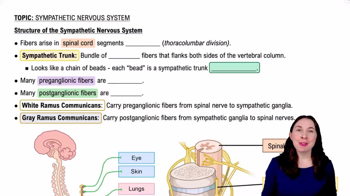Here are the essential concepts you must grasp in order to answer the question correctly.
Spinal Cord Anatomy
The spinal cord is a cylindrical structure that extends from the base of the brain to the lower back, typically ending at the lumbar region. It is encased in the vertebral column and is responsible for transmitting nerve signals between the brain and the rest of the body. Its length varies among individuals but generally measures about 42 to 45 centimeters in adults.
Recommended video:
Gray and White Matter
The spinal cord is composed of gray and white matter, which have distinct functions. Gray matter, located centrally in an 'H' shape, contains neuronal cell bodies and is involved in processing information. White matter surrounds the gray matter and consists of myelinated axons that facilitate communication between different regions of the spinal cord and the brain.
Recommended video:
Spinal Roots
Spinal roots are the structures that emerge from the spinal cord and connect it to the peripheral nervous system. There are two types: dorsal (sensory) roots, which carry sensory information to the spinal cord, and ventral (motor) roots, which transmit motor commands from the spinal cord to muscles. Each spinal nerve is formed by the merging of these roots, allowing for coordinated movement and sensation.
Recommended video:
Structure of the Sympathetic Nervous System
 Verified step by step guidance
Verified step by step guidance


